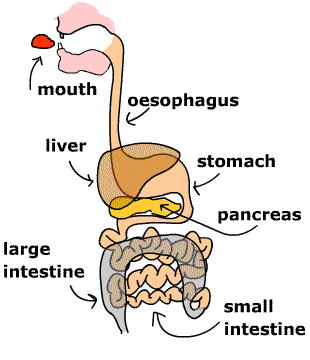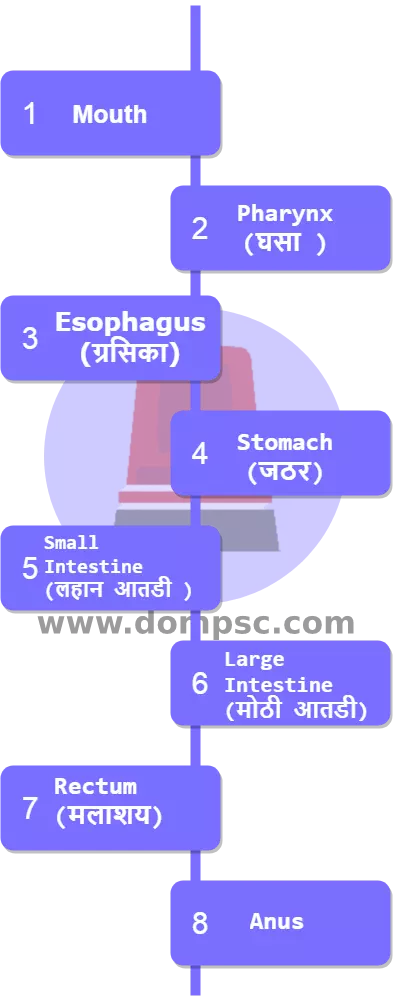MPSC Digestive system(पचन संस्था)-MPSC Biology science notes

✪ Download pdf Works Properly on chrome Browser ✪
Digestive system(पचन संस्था)
Table Of Contain-Mpsc Digestive system(पचन संस्था)
Introduction of Digestive system

By Shubham Vyawahare
0-May-2025
➤ the important factors present in the body are carbohydrates,proteins and fats.
➤ Absorption process absorb the important factors from food and provide to blood cell and tissue to perform body work.
➤ But this cant be done directly from food that has eaten.
➤ The process of converting complex food in to a very simple format by adding some chemical substances is called as digestion.
➤ this is a the process of making food soluble in water.
➤ This is the process of mixing of food in the one format.
➤ This process required chemical and physical reactions.
✪ Human Digestive System ✪
➤ Human Digestive system mainly consist of teeth,mouth,tongue,alimentary gland,digestive gland and several chemicals.
➤ Following are the main components of a human digestive systems. How food Travel in the body.

✪ Human Digestion ✪
➤ The human Human Digestion defend on following factors.
1.Mouth
➤The mouth is an oval-shaped cavity inside the skull..
➤ he two main functions of the mouth are eating and speaking.
➤ Parts of the mouth include the lips, vestibule, mouth cavity, gums, teeth.
2.Teeth
➤teeths are the cutting arms of a human body to break a food.
➤ Teeths are placed in the jaw bones
➤ There are two sets of teeth and placed symmetrically in the mouth
➤ Young human has a 32 teeth in his mouth.
➤ There are 4 types of teeth present in the mouth
➤ 1.Incisor- 8 teeth
➤ 2.canine- 4 teeth
➤ 3.premolar-12 teeth
➤ 4.Molar- 8 teeth
➤ Formula of a teeth is - I,C,P,M
➤ strong outer structure of a teeth is Enamel
➤Wisdom teeth grow up in the mouth after a person became 16 to 17 years old.
➤ Human Teeth structure is also known as a diphyodont dentition because of its structure.
3. Tongue
➤The main functional work of a tongue is to test the taste of food.
➤There are some Taste buds present on a teeth to taste a food
➤ bladder stores urine, allowing urination to be infrequent and controlled. ➤ But taste buds present in a different part of tongue.
➤ Sweet taste-Discover at a front side of tongue
➤ Bitter taste-Discover at a middle side of tongue
➤ salty and Sour taste-Discover at a both side of tongue
✪ Gland Present In Mouth ✪
➤ Gland is part of body which secrete some chemical substance to perform a particular work.
➤ there are lots of gland present in the human body with there own special functionality
Some of them are found in human Mouth.
Salivary Gland
➤ Saliva is produced in and secreted from salivary glands
➤ There are also several hundred minor salivary glands throughout the mouth and throat.
➤ Saliva drains into the mouth through small tubes called ducts
➤ Ptyalin enzyme is an amylase enzyme produced by the salivary glands (salivary glands)
➤ ptyalin which is capable of breaking down starch into simpler sugars such as maltose and dextrin that can be further broken down in the small intestine
➤ Amylase enzyme basically found in a human mouth
➤ There are 4 types of salivary glands found in mammals
➤ Parotid Gland
➤ submandibular Gland
➤ Sublingual Gland
➤ Zygomatic Gland
✪ Stomach ✪
➤ The stomach is a muscular organ located on the left side of the upper abdomen
➤The stomach is a J-shaped organ that lies between the esophagus and the small intestine
➤ It has three main functions: Stores ingested food and releases it into the small intestine
➤ Layers of the stomach wall, among others, include serosa, muscularis, submucosa, mucosa.
➤ It can take between four and 11 hours for food to pass into the large intestine (six to eight is average), and it will spend up to 70 hours
➤Peristalsis is a series of wave-like muscle contractions that moves food to different processing stations in the digestive tract.
➤Fiber-rich foods such as whole grains, leafy vegetables and fresh fruits will add bulk to your feces and help stimulate the bowel to push food along
➤Peristalsis is a normal function of the body. It can sometimes be felt in your belly (abdomen) as gas moves along
➤The process of peristalsis begins in the esophagus when a bolus of food is swallowed.Jun
✪ Gland Present In Stomach ✪
➤ Gland Which are present in the stomach wall is called as stomach glands
Gastric Glands
➤Gastric Gland secrete a gastric juice
➤Three important components of gastric juice
- Pepsin:Pepsin is the chief digestive enzyme in the stomach that breaks down proteins.
- HCL:Highly Concentrated HCL acid is required for process of pepsin
- MucusEffects of Highly Concentrated HCL acid is prevented by mucus.
✪ Small Intestine ✪
➤ Small intestine, a long, narrow, folded or coiled tube extending from the stomach to the large intestine.
➤ it is the region where most digestion and absorption of food takes place.
➤ It is about 6.7 to 7.6 metres.
➤ Small intestine are longer than large intestine but less in diameter shape
➤ Small intestine are divided in to three parts
➤Duodenum:The shortest region is the 25.4-cm.
makes a C-shaped curve around the head of the pancreas before ascending anteriorly again to return to the peritoneal cavity and join the jejunum
➤ Jejunum:The jejunum is the second part of the small intestine in humans
➤Lleumb:Ileum, the final and longest segment of the small intestine. It is specifically responsible for the absorption of vitamin B1
✪ Gland Present In Small Intestine ✪
There are two important glands present in the small intestine
Pancrease
➤Basically pancrease secret main three factors
➤ 1.amylase: Convert Carbohydrates into Glucose
➤2.trypsin: Convert Protein into Amino Acid
➤2.lypez: Convert Fats into Fatty acid
Liver
➤liver is a large meaty organ that sits on the right side of the belly
➤ Mostly Secretes a Bile juice
➤Bile juice is a fluid that is made and released by the liver and stored in the gallbladder
➤ It breaks down fats into fatty acids, which can be taken into the body by the digestive tract.
✪ Large Intestine ✪
➤The large intestine, also known as the large bowel, is the last part of the gastrointestinal tract and of the digestive system
➤ The main regions of the large intestine are the cecum, the colon, and the rectum
➤ The large intestine has 3 primary functions: absorbing water and electrolytes, producing and absorbing vitamins, and forming and propelling feces toward the rectum for eliminations
➤ The large intestine or colon has one primary role, water and electrolyte absorption to concentrate the stool. It plays little role in metabolism and people can live full lives without their large intestine.
✪ Digestion Process Steps InHuman ✪
- Ingestion:Taking food from mouth
- Digestion:Convert Complex food into soluble food
- Absorption:Digestive Food taken by blood
- Assimilation:Food Taken by Blood is Transfer toward a cell and tissue
- Egestion:Removal of waste food
✪ Disease Related With Digestion ✪
✪ Jaundice-Jaundice, also known as icterus, is a yellowish or greenish pigmentation of the skin and whites of the eyes due to high bilirubin levels
✪ Vomiting- throwing up, is a forceful discharge of stomach contents
✪ Constipation-Occurs when bowel movements become less frequent and stools become difficult to pass
Others Blogs Related to MPSC Biology Notes
➤Biology Exam Pattern
➤Blood Circulation System
➤Blood Groups And Its Diseases
➤Balanced Diet And Nutrients
➤Classification Of Animals
➤Classification OF Plants
➤Cell
➤Tissue
➤Coordination In Human
➤Digestive System
➤Diseases And Disease Types
➤Excretory System
➤Respiratory System
➤Reproductive System
➤Skeletal System
Read All MPSC blogs
- ➤केंद्र सरकारने खाजगी क्लासेस साठी नवी नियमावली लागू केली आहे |GUIDELINES FOR REGULATION OF COACHING CENTER in marathi
- ➤MPSC Data leak: पेपर न फुटल्याचा दावा MPSC आयोगाने स्पष्टपणे केला आहे
- ➤MPSC hall ticket data leaked before 6 days of exam
- ➤MPSC Data leak: टेलेग्राम वर अचानक ९० हजार परीक्षार्थींचे प्रवेशपत्र झाले लिक
- ➤मराठी भाषेला अभिजात दर्जा मिळायला हवाच , अभिजात दर्जा नेमका कसा मिळतो ?
MPSC Books pdf



